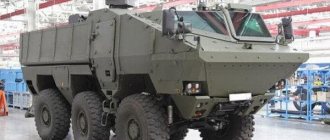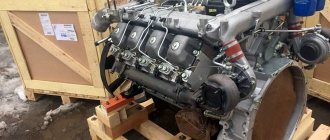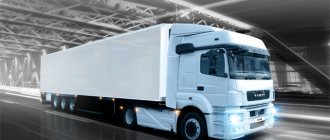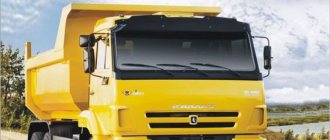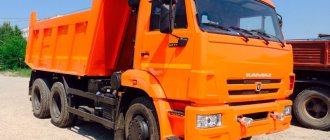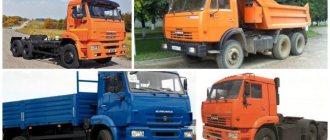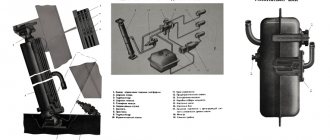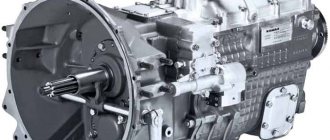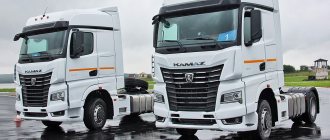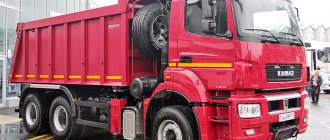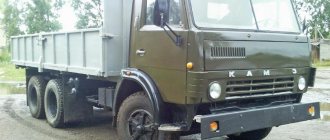KamAZ vehicles used for a wide variety of areas. They are indispensable for various civil purposes, in particular for use in construction, municipal and other areas (see universal dump truck 6520). However, a separate milestone is the production of trucks for various military purposes and tasks.
This strategic task was set for many automobile factories in Soviet times. This is completely understandable, because in those days a huge amount of resources were allocated for military purposes, because the state policy itself was focused on this.
But even at the present time, the automotive industry has become very popular, focused on the production of trucks for various military purposes , which KamAZ successfully copes with to this day. This concern was a participant in various ratings of the most successful and profitable factories, which allowed it to gain sufficient authority in the international arena. Kamaz releases new models of equipment, which you can read about separately here.
The same can be said about KamAZ military vehicles, which are in great demand among the military (see Kamaz - Punisher), and more recently a new development from Kama appeared (KAMAZ 63968).
History of appearance
The plant began developing the model in 1987; the task was to create a highly cross-country model capable of moving at an altitude of 4,000 meters above sea level, with the ability to install additional superstructures and standardized parts.
Initially, it was planned to build the KamAZ-5350 on the basis of the KamAZ-4310, which showed excellent results in Afghanistan, but the requirements did not allow the use of its platform. A new platform was created, which was subsequently used to produce a 15-ton tractor, KamAZ 53502, 53503 and 53504.
After a while, the Russian army froze the re-equipment project for 10 years, which suspended development. As a result, the finished prototype was presented at the Nizhny Novgorod exhibition in 1995. The vehicle was equipped with all modern technologies, and after certification and necessary modifications in 2002, it entered the fleet of the Russian Armed Forces.
All requirements are satisfied:
- towing trailers up to 12 tons;
- 85% of parts fit from other company equipment;
- ability to cross 4600-meter passes;
- you can install any add-ons that are suitable in size;
- Excellent maneuverability for a truck.
The production of equipment continues to this day, despite the appearance of new models of the Mustang series. The government agency does not refuse this machine, and some were able to get one for civilian use.
Description and scope of application
KamAZ Typhoon
For the first time, people started talking about the Typhoon project quite a long time ago , which led to the fact that in 2010 the first mock-up of the future truck was developed and demonstrated at an arms exhibition. At the moment, the project is in its final stage, and the models themselves have already arrived at the relevant departments.
It is worth noting that the truck was developed on a standard 6x6 chassis. Depending on the configuration, a cabin and a special module are installed on the chassis, designed for transporting troops to combat areas. In addition, instead of a landing module, you can install an open platform and a body for transporting various cargo, including military cargo.
Due to the fact that in this truck special attention is paid to the power plant and protection of military personnel, the distribution of load along the axles of the vehicle has changed. In particular, both front axles turned out to be steerable, and the second pair of wheels was significantly moved forward.
The package includes a hydropneumatic suspension that can change the width of the ground clearance.
The Typhoon configuration includes a cabin covered with armor protection, followed by a motor casing. Behind is a module designed to transport troops, or various military cargo and uniforms. Some drawings show that this module is connected to the cab, allowing freedom of movement between parts of the truck.
Armored Corps
The body of the armored car was supplemented with various protective elements consisting of ceramics and metal, providing overall protection against various types of ammunition. In particular, the case can withstand 14.5 mm bullets, which corresponds to the fourth class of protection.
Subsequently, such powerful armor was abandoned, because it negatively affected the overall mobility of the truck, and in the conditions of combat operations this could end fatally. A later version corresponded to the third class of protection and could withstand 7.62 mm bullets.
The armored car has a mine-resistant V-shaped bottom , which allows it to withstand the explosions of various artillery shells and explosive charges. Tests showed that a six-kilogram charge placed under the wheels of the truck caused some damage to the equipment, but the entire crew remained unharmed (it is clear that the tests involved not living people, but dummies).
In models where there is no direct passage from the cockpit to the landing module, there are three seats for crew members. The landing module contains 16 seats, which are also protection from the impact of an explosive device located under the bottom. Communication with the crew located in the truck cabin is provided.
Depending on the customer’s requirements, it is possible to install various combat elements on the truck, including a machine gun mount. In addition, as planned, a combat module can be installed on the truck, which will be controlled remotely from the inside.
This truck is part of a state order aimed at providing military units and GRU special forces with the necessary equipment. It is planned to be used during various military operations in different territories.
In addition to transporting cargo, including for military purposes, Kamaz vehicles actively participate in racing. One of these models is the Bonnet Kamaz.
On our website you will find a lot of useful information about Kamaz. Here is an overview of the sizes of different models.
Here is a description of how much and what materials can fit in the body of a Kamaz.
Modifications of KamAZ-5350
The vehicle is designed to carry passengers, but the Army has created its own additional armored module MM-501 for 14 armed passengers. The module can be installed in 30 minutes, is equipped with a heater, an intercom and is made of 44 mm steel.
Additionally, the armed forces use the truck to install more than 350 weapons, including: maintenance vehicles, multiple launch rocket systems, KUNGs, etc.
Other examples include modifications to a flatbed truck, a vehicle with PLIT measuring equipment, and a drilling rig.
Ideal truck
The Soviet army divided military trucks into two types: rear and tactical. The first were essentially modernized or ordinary civilian trucks, such as the first Soviet truck, the AMO-F-15. The latter were developed on the same chassis, but directly for the army, and their main difference was their high maneuverability. This is, for example, the YAG series, which eventually became the ancestor of the first Soviet three-axle truck - the YAG-10. To meet the needs of the armed forces, the modern Russian military truck fleet includes the following varieties:
- special wheeled chassis;
- tracked vehicles;
- multi-purpose vehicles;
- wheeled tractors;
- trailers and semi-trailers;
- container bodies and multi-purpose van bodies.
The comparison with the Soviet Union can be continued in terms of capabilities. The limited capabilities of the first decade of the USSR were expressed in the fact that Soviet engineers did not hesitate to remake “for themselves” the products of the rotten West. The alteration, however, almost always benefited her. It is no secret, for example, that the GAZ-62 is a Dodge WC-52 modified for difficult conditions, and the GAZ-AAA is built on a Ford basis.
Fragments of testing military equipment:
The legendary trucks of the past Ural-375, GAZ-66, UAZ-469 and ZIL-131 were the basis of the design, from which, by adding various cabs and superstructures, vehicles for various purposes were obtained. The development principle remains the same today, because in essence Russian military trucks are expanded Soviet designs. True, today the emphasis is not on a wide fleet of vehicles, but on multi-purpose use. The ideal, but not yet built, truck of the Russian army should have the following advantages:
- design versatility;
- the possibility of transporting goods;
- adaptability to install weapons;
- trailer towing;
- solving problems in both war and peacetime.
Cabin
Several versions of cabins are offered, firstly, the height of the roof and the presence of a hatch on it differ, and secondly, some versions of the KamAZ-5350 are equipped with a berth in addition to 3 seats. There is a compartment for weapons inside.
Due to need, we had to make a V-class armored capsule on reinforcements with additional armored external panels. The windshield is made of several bulletproof blocks. To avoid fires and explosions, it was necessary to armor the fuel equipment and the engine crankcase.
Inside the 5350, everything is done like in regular KamAZ trucks, but it’s much more comfortable to be inside. The armor together with sound insulation gave an excellent effect of silence, and in winter the heater connected to the engine cooling system saves the day.
Naturally, for servicing the engine, the cabin is made folding. The cabin is raised by a hydraulic cylinder with an articulated joint, and fixed on two more spring supports.
AZ "Ural": three new products
And this time Automobile pleased us with new products. The first is “Ural-43206-07010” (4x4), part of the “Motovoz-M” family. This car is distinguished from the production model "Ural-43206-0011" by a new three-seater frame-panel cabin, a new front end design and tail - all this is unified with other models of the family. The second new product is the Ural-63708 Tornado-U (8x8) with a protected 4-door five-seater cabin. And the third new product is the Ural-63706 Tornado-U (6x6) with a 3-seat protected cabin, which, unlike the previously shown options, is equipped with a machine gun turret.
I note that the unified cabins of the family can be 3-, 5- and 6-seater, equipped with ventilation, heating, air conditioning systems, and a filter-ventilation unit. All cabins fully comply with the current and future requirements of the Russian Ministry of Defense in terms of ergonomic parameters and exposure to external climatic factors, and the protected cabins meet the requirements for protection from firearms and the damaging factors of explosive devices.
Part 1 Part 2 Part 3 Part 4
Part 5 Part 6 Part 7 Part 8
KamAZ-5350 engines
| Characteristics | Indicators |
| Maximum speed, km/h | 100 |
| Engine | Diesel turbocharged |
| Cylinder arrangement | V-shaped |
| Number of cylinders | 8 |
| Working volume, cm3 | 10857 |
| Power, hp | 260 |
| Torque, H*m | 1079 |
| Combi consumption, l per 100 km | 27 |
Initially, the vehicles were equipped with a KamAZ-740.13-260 diesel engine, but after entering the ranks of army vehicles, they began to install a modified 740.30-260 engine. Their design is approximately the same - it is a 10.85-liter turbocharged 8-cylinder diesel engine producing 260 horsepower.
The difference is in the increase in torque in the second from 932 to 1079 H*m. The engineers also managed to reduce fuel consumption, amounting to 27 liters per 100 km from two tanks (125 and 170 liters).
The engine does not comply with modern environmental standards - Euro-2. The maximum speed of the KamAZ-5350 is only 100 km/h, but for this class this is a decent indicator.
Transmission
The engine is paired only with a 10-speed manual transmission, transmitting torque to all three axles. The torque is transmitted through a 2-speed transfer case connected to a cardan. The box consists of a 5-speed gearbox and a divider installed in front of the gearbox itself.
For ease of switching, the single-disc, pull-type diaphragm clutch is supplemented with a pneumohydraulic booster.
The vehicle's cross-country ability is also good thanks to the locking of the cross-axle differentials at the rear.
Suspension and brakes
For passenger comfort and good cross-country ability, engineers used semi-elliptical springs with telescopic shock absorbers at the front, and spring-balanced suspension at the rear. The rear suspension consists of two longitudinal springs coupled with two telescopic shock absorbers.
The chassis of the KamAZ-5350 made it possible not to move the body vertically when one wheel hits an obstacle. Plus the suspension reduces shock to the frame to save knots.
There are several brake systems on vehicles. The main one operates from a double-circuit pneumatic drive. There is also an engine brake, called an auxiliary brake, to reduce the load on the pads. For non-standard situations, a spare brake system 5350 is installed, which can be used if the main one fails. The last one is the handbrake or parking brake.
An electronic brake condition analysis system is installed, which emits a signal in the event of a malfunction.
The best military vehicles of OJSC KAMAZ will be shown in Zhukovsky
KAMAZ-5490
is a new truck tractor developed in close cooperation with the German company Daimler AG. A distinctive feature of the car was the cabin, which was based on the Mercedes-Benz cabin from the Axor family.
Modern design and its streamlined shapes have significantly improved not only the aerodynamic characteristics of the truck, but also its consumer properties. Significant changes have taken place in the salon itself. Behind the driver and passenger seats there are two sleeping places, not inferior in comfort and size to a home bed.
For the convenience of the driver and passenger, the seats are equipped with a pneumatic system. In addition, the package includes many electronic systems that will greatly facilitate the driver’s life on the road. In particular, the car received air conditioning, cruise control, which ensures safe driving, electric windows and an adjustable steering column, allowing the driver to adjust the position of the steering wheel to suit himself.
The high roof made it possible to place several additional and spacious shelves on the panel above the windshield. These innovations have significantly increased the level of comfort in the cabin of the new KAMAZ. When creating the car, designers paid great attention to active safety.
KAMAZ-5490 uses electronic systems such as EBS, ESP and ECAS. The Electronically Controlled Braking System (EBS) allows you to shorten the stopping distance of your vehicle and reduce brake lining wear. According to experts, the new tractor unit is a significant technological breakthrough in the production of vehicles for commercial cargo transportation. Thanks to its consumer properties, the machine can count not only on the Russian, but also on foreign markets.
KAMAZ-5490 / Photo: ca.d-cd.net
Tactical and technical indicators
| Wheel formula | 4x2 |
| Busbar type | 2 |
| G/p, t (load/SSU) 10.55 | 10,55 |
| Power engine hp | |
| nominal power (gross) | 428 |
| max useful power (net), indicated in OTTS, OTSH and PTS | 428 |
| Model | Gearbox ZF16 |
| Final drive gearbox | 3,077 |
| Sleeping area | 2 |
| Tires | 315/60R22.5 |
| Tank, l | 2x400 |
| SSU height at full/curb weight, m | 1100 |
| Features of the vehicle | ICD, door Daimler OM457LA (Euro-5), gearbox 16S2221 with intarder, rear. Daimler HL6 axle, ECAS, neutralization system. Exhaust gas (AdBlue), EBS, ESP, ASR, cab. Daimler, air suspension cable, air conditioner |
Dimensional characteristics and cross-country ability
Truck dimensions:
- length – 796 cm;
- width – 255 cm;
- height – 329 cm;
- front base – 205 cm;
- rear base – 255 cm;
- ground clearance - 39 cm.
Naturally, with add-ons, the dimensions of the equipment change. I was also pleased with the maneuverability of the KamAZ-5350 - the turning radius is 11.3 meters.
Dimensions of the platform for installation of drilling rigs, cranes, tanks, etc.:
- length – 489 cm;
- width – 247 cm;
- side height – 73 cm.
Due to all the equipment and its size, the vehicle is capable of overcoming 31-degree slopes, a 0.6-meter ditch and a 1.75-meter ford.
| Characteristics | Indicators |
| Curb weight, kg | 9 650 |
| Load capacity, kg | 6 000 |
| Gross vehicle weight, kg | 16 850 |
| Total weight of the towed trailer, kg | 12 000 |
| Gross weight of the road train, kg | 27 850 |
In terms of load capacity, the curb weight is 9,650 kg (with a winch), and the frame is ready to accept no more than 6 tons, creating a maximum weight of 15,850 kg. The machine also allows you to tow a trailer with a maximum weight of up to 12 tons.
Second wind
The Bryansk plant, which recently celebrated its 50th anniversary, was in limbo in the 90s, like many other manufacturers. However, today Russian military trucks continue to be replenished with products from this plant. The Voshchina-1 car, made in Bryansk, has good performance. The truck has both interaxle and cross-axle differential locking and an interesting tire pressure regulation system.
The new BAZ models 6306 and 6402 are also in demand. For military chassis, the plant offered the BA3 69506, equipped with a 300-horsepower YaMZ 238 engine and a bridge circuit for distributing transmission power. New models of military trucks are being developed based on already standardized families. A good example is the 80% unified models of Ural and KamAZ trucks.
The Ural-375, developed in the 60s, became the basis for such machines as the Ural-4320 and the modern Ural-43206.
The experience of modern military operations proves the need to create highly protected and highly mobile vehicles. Additional armor was successfully implemented on the Ural 4320 vehicle. The Ural cabin is equipped with external armor and armor linings. A bulwark to protect the rear wheels and radiator protection are also installed. Additionally, the roof and floor of the cabin and engine are protected by armoring the tail and hood elements. When glazing the windshield and doors, 33 mm armored glass is used.
Implementation of additional protection for Ural-4320.
The same approach to protection has been developed for ZIL 4320, KamAZ 43101 and others. Increasing the survivability of military trucks is achieved by using armored glass, bullet-resistant fuel tanks and combat-resistant tires made from the best modern materials. Interesting developments are being promoted to the Russian army truck fleet by KRAZ. The model with the number has a three-axle bogie connected to the cabin axis, i.e. formula "3+1". The truck is powered by a 400-horsepower YaMZ-7511.10 engine.
More on the topic: Kenworth trucks
Jüterbog Military Equipment Festival (2013):
KZKT 8014
The Kurgan plant of multi-axle tractors has a glorious history of almost half a century. Products from Kurgan began arriving in the Soviet troops in 1963 - the pioneer was the four-axle Uragan tractor, built on the basis of the MAZ-537, the plant’s own design. To replace the same MAZ-537 in the 90s, KZKT was developing the Rusich model range, the first truck of which bore the identifier 7428. The distinctive features of the new truck are a hydromechanical transmission and a powerful YaMZ-64011 engine (650 hp)
Having survived difficult times in the 90s and was renamed JSC Rusich, the company was able to return to the list of main suppliers to the Russian army. Based on the unification of the 7428 tractors produced by the plant since 1990, a range of chassis KZKT 8003 (6x6), KZKT 8005 (8x8) and KZKT 8014 (10x8) with a load capacity of up to 13, 27 and 40 tons, respectively, was developed. Other technical characteristics of KZKT-8014:
- Wheel formula - 10x8;
- Weight in running order – 26 tons;
- Load capacity – 40 tons;
- Fuel tank capacity – 900 liters;
- Engine - 4-stroke V-shaped or in-line diesel engine with powers of 470 and 475 hp;
- Maximum speed – 60km/h;
- Number of seats in the cabin - 2.
The trucks are designed to transport various weapons systems, as well as heavy oil and gas equipment and platforms. TMZ and Cummins power units have a large margin of safety, and the truck’s five axles allow it to navigate the most severe off-road conditions. The commercial use of Rusich ballast tractors is also developing.
Multipurpose chassis KZKT-8014 (10x8)
Cargo armored car "Typhoon"
In June 2011, the latest armored vehicles of the Typhoon family were presented in Bronnitsy, which are not inferior, and in some aspects superior to foreign MRARs. Typhoon is the first development created from scratch, not a modification. The project is being carried out by the Ural and KamAZ plants. The armored vehicle is being developed in several directions - 3-wheeled formulas (6x6, 4x4, 2x2) and 3 body modifications (hoodless, bonnetless frame and bonnetless body).
Armored car based on KamAZ - 63968 "Typhoon"
It is assumed that the vehicle will deliver military units to the site of hostilities and participate in them. The curb weight of the car is nine and a half tons, the total weight is seventeen tons. Fuel consumption – 35 liters. Typhoon can travel about 630 km without refueling. The maximum speed is 80 km/h. The typhoon calmly overcomes slopes with a slope of 23º and fords up to 1.75 meters deep (the driver is already sitting waist-deep in water)
Another Typhoon representative based on Ural-63095.
Armored personnel carrier DT-30PM "Vityaz"
In 1986, the DT-30PM Vityaz tracked armored personnel carrier was adopted. The Vityaz model is the only vehicle that can overcome the off-road conditions of the Far North, Siberia and even the Arctic. In addition, they can work perfectly in high altitudes and in places with high humidity. The maximum developed speed on land is 45 km/h, afloat – 5 km/h, engine power – 800 hp, cruising range – 700 km. The transporter's loaded weight is 29 tons, load capacity is 30 tons, capacity is 5 people.
More on the topic: DongFeng trucks: guests from China
In essence, this vehicle is a response to American developments, although Russia, as usual, goes its own way: successful projects with an articulated tracked base can be counted on one hand, and for this reason the DT-30 is a unique vehicle. The truck is capable of overcoming water obstacles up to 180 cm deep. At the same time, the amphibious modification (prefix “P” in the name) is capable of moving on any surface, be it water, snow, stone.
The Vityaz two-link transporter is designed for transporting military equipment, weapons, ballistic missiles and personnel.
Floating conveyor PTS-4
In the near future, the PTS-4 floating transporter will enter service. The floating conveyor is designed to move large cargo, armored vehicles and personnel through water obstacles. The previous model (PTS-3) had a unique installation for self-digging and at low speed (12-15 km/h) could transport up to 16 tons of cargo through water obstacles.
PTS-4 is based on elements of the Russian T80 tank: torsion bars, tracks, tracks, and the gearbox and clutches are taken from the T72. The transporter is equipped with a tank engine of 840 hp. The PTS-4 is equipped with a 12.7 mm anti-aircraft gun with remote control. The new model will be equipped with an anti-aircraft machine gun with a reserve of 400 rounds, and the machine gun will be controlled remotely.
Floating conveyor PTS-4.
Loading equipment onto the PTS-4 conveyor.
The conveyor was created by the Mechanical Engineering Design Bureau of the Uralvagonzavod corporation. The total weight of the vehicle is 33.1 tons, the maximum speed on land/water is 60/15 km/h. The length of the vehicle is 8.3 meters, width is 3.3 meters, range is 600 km.
Price and withdrawal
New such machines are sold to civilians at a price of 2 million rubles and up to 4 million for a crane truck. The military armored version costs more. There are offers on the used market for an average of 1.7 million rubles. It is inexpensive considering the class of equipment and its capabilities.
There are some disadvantages, for example, an incorrectly installed steering linkage, which can be torn out off-road. Otherwise, it’s not for nothing that the KamAZ-5350 has been in the ranks of army vehicles for many years and is still being purchased. This brings to mind the impressive reliability of the equipment, suitable low-cost maintenance and maneuverability in harsh military conditions.
Peculiarities
KamAZ cab
The protective properties of the cabin and module for transporting troops deserve special mention . During the tests, it was established that this truck is capable of withstanding various fragments from artillery shells.
In particular, shell explosions were carried out at various distances from the test object. It turned out that the Typhoon can withstand hits from fragmentation parts from high-explosive 152-mm shells located thirty meters from it. They decided not to stop the tests there, and tried to detonate a landmine at a distance of a couple of meters from the truck.
It is not surprising, but for the crew members whose roles were played by mannequins, there were no negative consequences , which cannot be said about the armor of the car.
In addition, six kilograms of TNT were placed under both wheel sets of the car. The special mine-resistant bottom included in the truck's design passed this difficult test with flying colors. What is meant here is that it prevented direct impact on the crew, which is the main purpose of armor on a vehicle.
Of course, damage was caused to the hull and bottom, but these are the harsh realities of combat operations.
Other features of this model include the fact that it has a number of intraspecific modifications:
- KamAZ 63969 is a truck with all-wheel drive .
- The package includes a machine gun mount, controlled remotely by the operator from the cabin.
- The model has armor belonging to the fourth class of NATO protection, which allows it to withstand hits from 14 mm caliber bullets.
- This modification is produced in small batches , depending on the order. Serial release is not provided.
- Typhoon 53949 – has a 4x4 wheel arrangement. It is used mainly as a means of transporting troops to places of hostilities.
